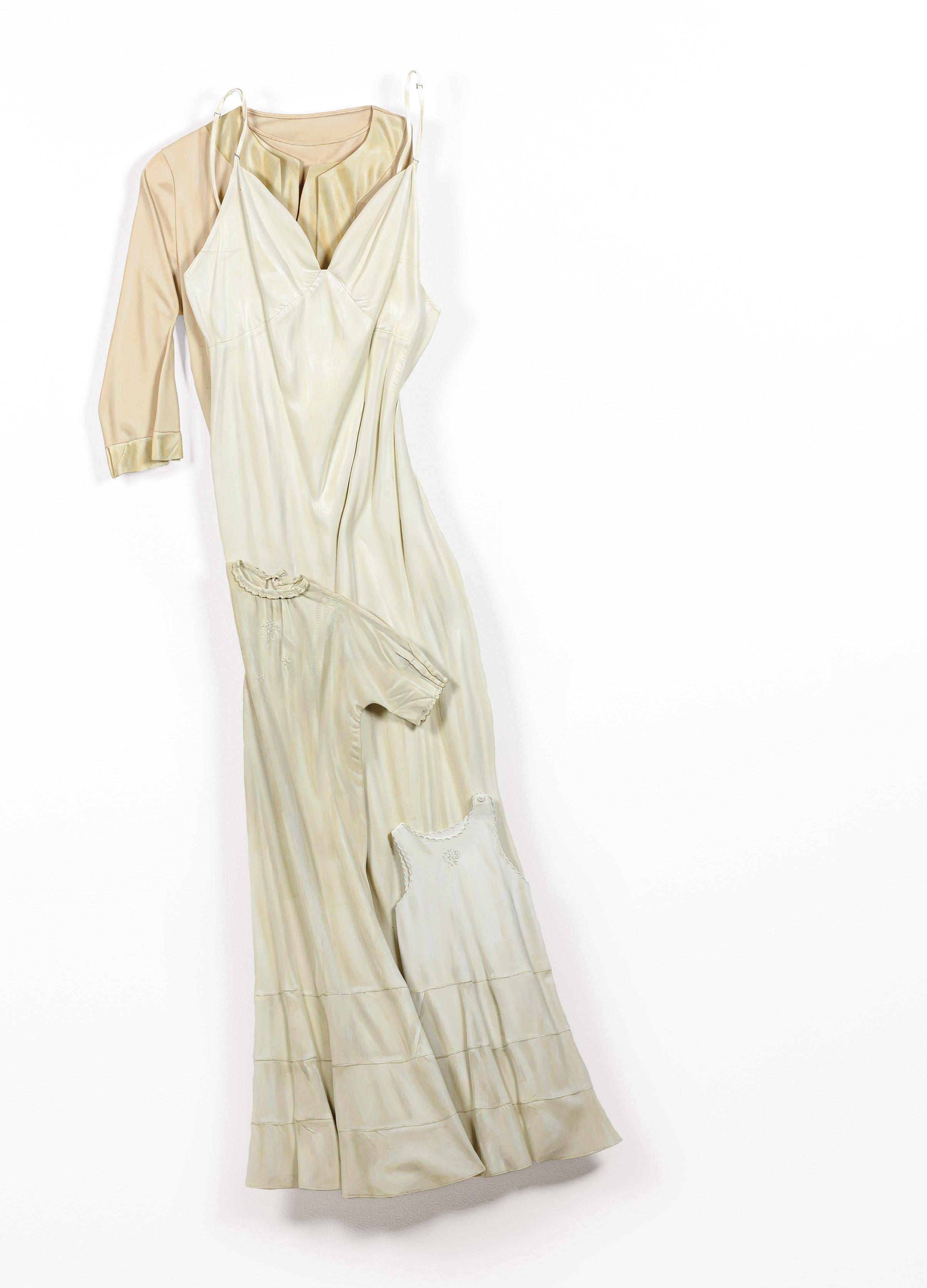
Collection Focus:
Ron Isaacs at RAM
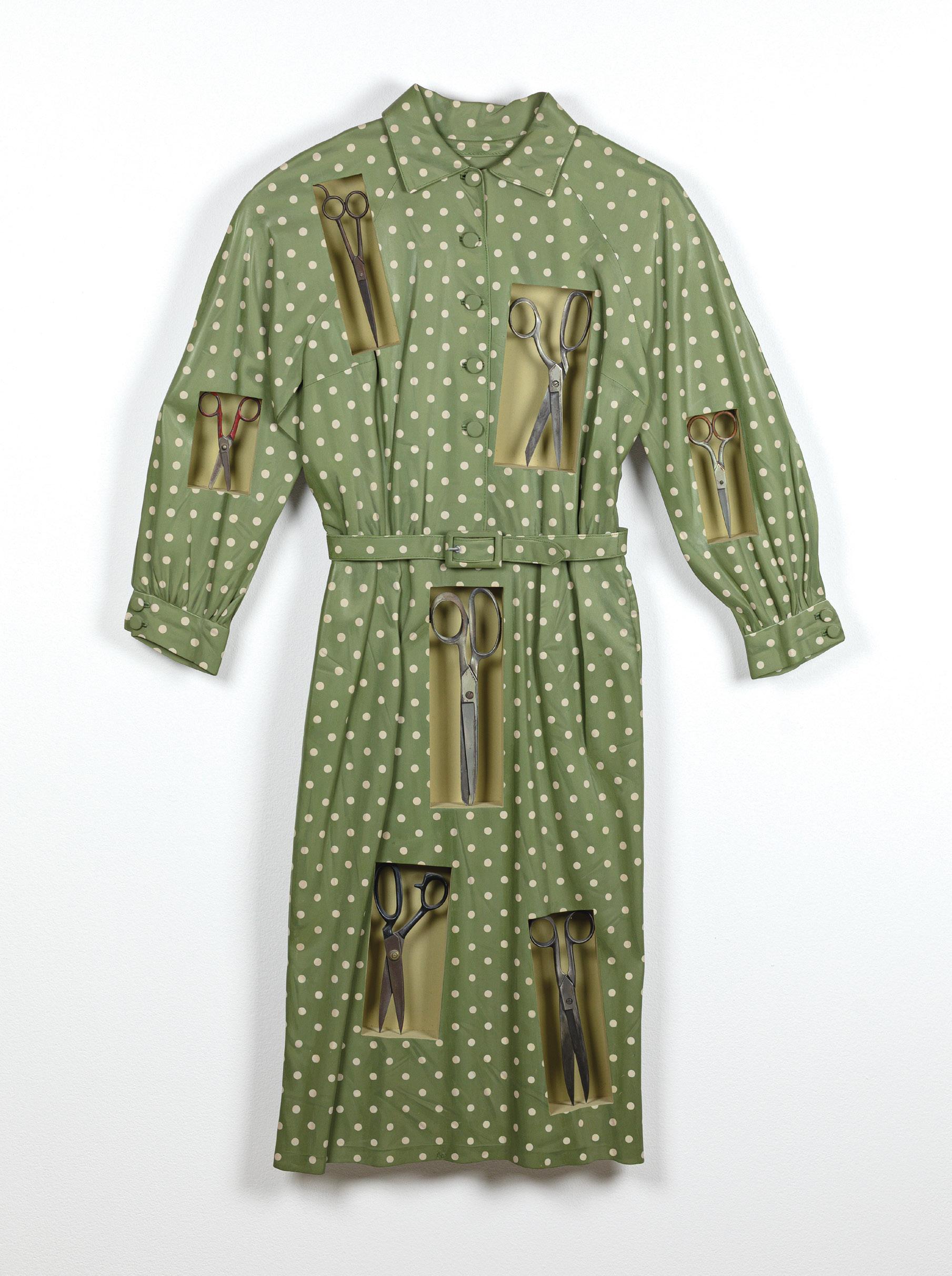
(front cover)
Figure 1
(above)
Figure 3
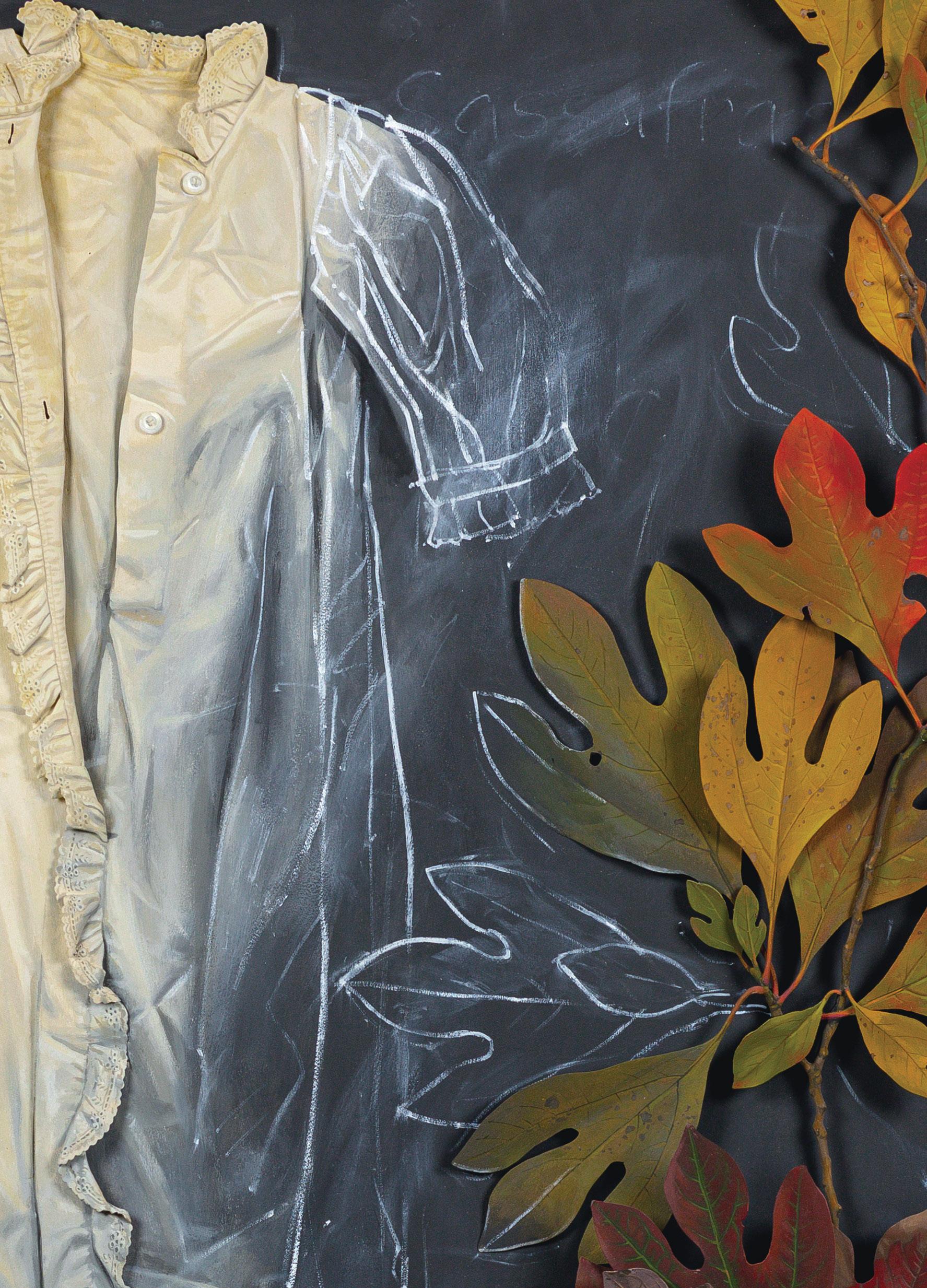



(front cover)
Figure 1
(above)
Figure 3

3 Collection Focus: Ron Isaacs at RAM Lena Vigna
9 A Conversation with Ron Isaacs and Bruce W. Pepich
First Edition
Copyright ©2025 Racine Art Museum
All rights reserved under International and Pan-American Copyright Convention. Except for legitimate excerpts customary in review or scholarly publications, no part of this publication may be reproduced or transmitted in any form or by any means, electronic or mechanical, including photocopying, recording, or information storage or retrieval systems, without written permission of the publisher.
Published in the United States by the Racine Art Museum (RAM), 441 Main Street, Racine, Wisconsin 53403.
Proofreaders: Rachel Comande, Laura Grayson, Jean Mandli, Jerome Mattick, Katelyn Mitchell, Bruce W. Pepich, Tyler Potter, and Lena Vigna, RAM
Designer: Tyler Potter, RAM Marketing Department
Printed in Waukesha, Wisconsin by The SCAN Group
All photography by Jarvis Lawson.
Collection Focus: Ron Isaacs at RAM is published on the occasion of the exhibition Collection Focus: Ron Isaacs, organized by the Racine Art Museum, Racine, Wisconsin, and on view from July 2 through October 25, 2025.
Racine Art Museum is grateful to the following sponsors:
Platinum Partners
The Estate of Karen Johnson Boyd
David Charak
Judith and David Flegel Fund
Ron and Judith Isaacs

Racine Community Foundation
United Way of Racine County
Barbara Waldman
Windgate Foundation
Diamond Partners
Ruffo Family Foundation
Ruth Arts Foundation
Diane Zebell
Gold Partners
Anonymous
A.C. Buhler Family
Robert E. Kohler Jr. Fund
Osborne and Scekic Family Foundation
Trio Foundation of St. Louis
W.T. Walker Group, Inc.
Wisconsin Arts Board
Silver Partners
Anonymous
Baird
Lucy G. Feller
Ben and Dawn Flegel
Sharon and Tom Harty
Dave and Judy Hecker
Paula Kalke
Horizon Retail Construction, Inc.
Johnson Financial Group
Racine Art Museum
441 Main Street
Racine, Wisconsin 53403
262.638.8300
ramart.org
Lang Family Foundation
Dorothy MacVicar
Jan Serr & John Shannon
Sandra Shove
Willard and Mary Walker
Bronze Partners
Sandy and Gus Antonneau
Carol Baylon
Rose and Peter Christensen
Dave’s Wine Garage
Educators Credit Union
Patricia and Richard Ehlert
Express Employment Professionals
Deborah Ganaway
Carol Griseto
Hitter’s Baseball
Bill and Debbie Keland
Nancy and Nick Kurten
Susan Manalli
Norbell Foundation
JoAnna Poehlmann
Rasmussen Diamonds
SC Johnson
Harold and Lois Solberg
Kathy Stanghellini
Tito’s
Twin Disc
Janna Waldeck
Barbara Waldman
Marc J. Wollman
Media Sponsor
Radio Milwaukee

What does the work mean? There is some mystery, some beauty, some drama, some surprise, and a little wit. There is much about being human and being part of or apart from the natural world. There is a lot about the passage of time and the persistence of the past. There is a great deal about celebrating the joy of seeing. That said, the content remains nearly as open for me as it does for you, the viewer.
—Ron Isaacs
As a person, Ron Isaacs is thoughtful, straightforward, and engaging. As an artist, he is more of a trickster—creating artwork that initially appears straightforward even when it is not. Trained as a painter, Isaacs uses his ingenuity and skill to create poetic work full of illusions and narrative. More specifically, he crafts wood constructions that he then paints, with clothing, leaves, and found objects being popular themes. But, it does his work no justice to simply say they are painted representations. Those words aren’t nuanced enough to capture the essence of what he produces. Isaacs maneuvers his media so that a viewer doesn’t question what they are seeing until their brain catches up with their eyes.
Most of Isaacs’s work—a combination of two-dimensional imagery and cut and sawn wood—operates in an in-between space that he identifies as “trompe l’oeil painted constructions.” He further goes on to state, “I never actually made it to three dimensions; I seem to have stalled at two and a half.” 1
Traditionally, the phrase trompe l’oeil (French for fool or deceive the eye) is associated with two-dimensional imagery that appears to be threedimensional space or objects. While the phrase gained popularity in the early nineteenth century, illusionistic images—especially as associated with
artistic endeavors—were being created centuries before that in GrecoRoman mosaics, Renaissance cathedral ceilings, and Dutch still lifes. More modern interpretations include large-scale murals on building exteriors as well as street chalk drawings.
Trompe l’oeil artwork is regarded by some as the manipulation of materials with highly technical skill. In addition, there is a kind of humor implicit in the object’s creation—knowing that the viewer will likely have a moment of surprise or disbelief. Three-dimensional explorations of illusion have often included suggesting one material through another. Isaacs does this as he convincingly makes wood and paint appear to be fabric, plant matter, and numerous other things. Isaacs also layers ideas, and realities, as he combines illusionistic imagery with surreal set-ups, such as in Metaphor (fig 4) where torsos—one skeletal and one a suit jacket—seem to be made of branches and leaves that also appear animated even though they are disembodied. Similarly, the dress of The Sassafras Baby (fig 5) seems to be either forming from or dissolving into a sketch on a blackboard framed in leaves. Where does illusion end and reality begin? And vice versa?
In a theoretical sense, anything trompe l’oeil is surreal—a mental game and a collision of expectations. It is real (a real object and real materials) but also not real (it seems like something other than what it is). In a simultaneously unassuming and arresting way, Isaacs’s work operates directly in this space.


Isaacs does not regard himself as a proficient woodworker. In fact, while he admits that he has figured out how to do some things very well, he recalls that he found being on a panel with woodworkers and wood sculptors intimidating. 2 For the artist, wood was a logical choice to accomplish certain goals. When painting started to feel flat in the 1970s, Isaacs began to experiment with the shape and structure of the surface he was painting on. After attaching wood to a traditional canvas as a collage element, he started painting the wood shapes. Relatively quickly, he realized he didn’t need the canvas. From then on, paint and shaped wood merged into his trademark constructions.
A hallmark piece such as Polka Magnolia (fig 6) reflects the artist’s finesse with connecting structural form, surface treatment, and content. Imagine the dress and magnolia painted flat on a canvas or carved as 3-D sculptures— either of which could be fine, but they would likely not evoke the sense of wonderment or suggestion of transformation in the same way.
Isaacs has used Finnish and Baltic birch plywood, employing a variety of techniques to shape the material, especially sanding. In the simplest terms,
his process involves drawing, tracing, sawing, sanding, and painting. More directly, he pins a garment—or whatever object he is translating into his work—to a board that is gridded into one-inch squares. He uses the grid to draw a line pattern of the object form. Tracing paper outlines are used to break the form down into components that he can transfer to wood with carbon paper. Next, he creates outlines of shapes that can be sawed from wood and assembled with wood glue, with sometimes as many as 400 pieces of wood being used for a single object. He joins and sands components until he has a relief construction that is ready to paint. Sharing these details of process are useful as they ground artwork that can feel otherworldly or magical—it takes nothing away from it to share that the objects are born of concentrated labor and skill. In fact, it may make them all the more magical as they embody his perseverance and creativity in a profound way.

While Isaacs is humble about his abilities with wood, his early experiences reflect a connection to the material, to building things, and to using nature as a resource. The artist notes that when he was 12, his father built their home using trees cut from the nearby woods. He helped his father as much as he could, including sourcing the material and taking it to a sawmill. Arguably, this involvement with wood and construction gave him a taste of the material and its capabilities and limitations.
The emphasis on materiality in his work—Isaacs’s knowledge of how he can manipulate both wood and paint—is essential in communicating something otherworldly. Isaacs only lets the viewer in on the “illusion” when he wants to. This further links him to the historical traditions of trompe l’oeil where technical skill is a pivotal component in achieving successful work. Isaacs isn’t on a mission to show off his prowess. Rather, his genuine spirit shines through as his curiosity about the world and his interest in nature drive him to keep exploring. Of special note, while he universally keeps the work connected to nature and humankind, he does include a personal reference in the form of an “easter egg” that relates to beloved dog companions. This practice started when he was an art student and has continued through the inclusion of minuscule paintings “hidden” within the work. Of course, he is very clever with this, and finding the dog— being in on the secret—is another one of the rewards of extended viewing.

When Isaacs decided to create brooches, he, basically, made the wearer complicit in his illusions. When worn, life-size leaves such as Secret Life (fig 8) appear, in part, to have fallen off a tree and landed on a body. It is a poetic gesture connecting humans to the natural world in a tangible way while also subverting ideas about preciousness that are often associated with jewelry. It extends explorations of modern jewelers who were looking to upend notions of value and materials. They introduced non-precious materials that could, or could not, be imbued with sentiment, emotion, and ideas. Isaacs doubles down on this by creating something from non-precious materials that looks precious. While the brooches can be handled and worn, an actual leaf resting on a lapel would need attention and care. Secret Life, in particular, appears partly (albeit slightly unnaturally) decayed; it would need specialized attention to maintain its form were it a real-life thing and not just a representation. Isaacs complicates this narrative—and connects to some of his early and/or larger work—by sometimes adding in other elements, such as representations of rope, fabric, twigs, or other found objects. In some instances, he has constructed supports for when the brooches are not being worn, allowing them to be sculptural and displayable even off the body.
2 7/8 x 5 3/8 x 1/2 inches
(right)
Figure 9
Ron Isaacs
Corvus, 2007
Acrylic paint on birch plywood
44 1/4 x 35 1/2 x 5 1/2 inches
Racine Art Museum, Gift of the Artist
(opposite)
Figure 10
Ron Isaacs
Mother Mother, 1968
Acrylic paint on canvas 24 x 32 inches
Racine Art Museum, Gift of the Artist
Isaacs received his BFA from Berea College and his MFA from Indiana University—both with a focus on painting. He taught as a painting professor at Eastern Kentucky University for over 30 years, retiring in 2001. His work is featured in numerous public and private collections and has been exhibited extensively. Notably, examples of his work have also been featured in international publications—sometimes operating as an illustration of other ideas and not as art objects, per se. The fact that it has been used in this way is unsurprising. Isaacs’s choice of subject matter, as well as his sensitive and evocative treatment of it and of the materials he uses, gives the work weight and agency well beyond its tangible nature. As suggested earlier, Ron Isaacs has created compelling work that both relies on and sidesteps his skills—looking so much like the real objects being depicted that a viewer might forget it is made by hand. And in that space of forgetting and then realizing, magic is made. 4
Lena Vigna Director of Exhibitions


Bruce W. Pepich: Can you speak about your education and background? What first drew you to painting as a medium for personal expression? What aspects of painting as a medium have you maintained throughout your career?
Ron Isaacs: It’s a strange thing and a bit of a mystery, but the very first answer I ever gave, when someone asked me what I wanted to be when I grew up, was “Artist.” There is no family history or background for that answer; I had never encountered an artist, or had even seen much of anything that might be art. But, I never questioned it, never went through the cowboy or fireman stages. With much thanks to my mother’s support, I actually became an artist.
I was born in Cincinnati, an only child, seven weeks before Pearl Harbor. My parents were from extremely rural Jackson County in Eastern Kentucky. Both had been raised on smallish hilly subsistence farms with a little tobacco as the only cash crop, and my mother had taught in a two-room school. My father found work in a Cincinnati porcelain enameling plant, which did important war work and kept him busy through the war. We lived in Kenwood, a suburb of Cincinnati, on an eleven-acre island of marvelous property, which had been an old tree nursery that grew up. Our rented house was a very tiny cottage in the middle, which had been the office.
A Conversation with Ron Isaacs and Bruce W. Pepich
I was very shy, but I played well by myself, enjoyed the nature around me, and drew. In 1954, when I was 12, we moved back to Kentucky after my mother’s father died, to help my grandmother. We farmed, my mother taught again, and we built a house. Well, my father built the house, virtually single-handedly; I helped as I could, being somewhat awkward and bookish. We cut trees from our own woods, hauled them to the sawmill, and built a pretty nice ranch-style home.
At school in Ohio, I had an uninspiring art class maybe once a week. Then in Kentucky, through the rest of middle school and a socially hapless high school experience (the less said the better), I had no art training at all, though I seem to have served as the school artist and poster maker, and local sign painter. I kept up my own efforts and taught myself to paint as best as I could. I never gave much thought to sculpture, or had much exposure to it.
I received excellent grades, which helped me get into Berea College. At Berea, I majored in art, painted, and soaked up as much liberal arts learning as I could and bloomed. I managed to receive a Woodrow Wilson Fellowship, was accepted at Indiana University for graduate school, and earned my MFA in painting in 1965.
In Bloomington, I also met my wife, an extraordinary art-educator-to-be named Judy Andersen. She was from Long Island, of Norwegian parentage, red-haired, and wonderfully tall. She continues to be the best and most supportive artist’s wife possible.
At Berea, I had eventually figured out that I’d need another job to support being an artist, and that teaching art at the college level was the obvious best bet. I started at a tiny and underfunded junior college in London, Kentucky, as a one-man art department in 1965, then moved up the road to Richmond four years later to teach painting and drawing at Eastern Kentucky University for 32 years.
Beginning in 1973, I pursued an active career of exhibiting my work as best I could from the middle of Kentucky, eventually accumulating a promiscuous-sounding number of galleries which represented me in some form—a couple at a time—in New York, Chicago, Philadelphia, Detroit, Cincinnati, Milwaukee, Indianapolis, Lexington, Columbus, Ohio, and Asheville, North Carolina. They closed over the years, one by one (not my fault), except for only three. I just keep making things.
For our last 31 years in Richmond, we lived on a lake outside of town, in a house built for us on a seven-and-a-half-acre property that was mostly woods. More nature! Now we live in a townhouse in a pleasant neighborhood in Lexington, where I commute upstairs to my studio and workshop. At 83, in reasonable health and having heard of very few retired artists, I continue making art as hard as I can for as long as I can. Somebody’s got to make these things.
Pepich: What explorations led you to increase the sculptural component of your pieces so that you now create three-dimensional works? What kinds of changes occurred when you started adding three-dimensional elements into your compositions and painting on wood instead of working on canvas?
Isaacs: I never actually made it to three dimensions; I seem to have stalled at two and a half. While I was going through the process of working my way from flat to relief, a sculptor friend kidded me that someday I was going to invent sculpture all by myself. And I sort of did, for myself, even though I came to it through the back door.
By 1970, I was painting, on canvas, multiple-image figurative work based on magazine and newspaper photos, with some imagery from life. My primary influences were Robert Barnes, one of my teachers from grad school, and Roy Schnackenberg, a Chicago painter and illustrator. The latter had started using black outlines, which I used to unify the imagery and to flatten and confuse the space of the painting. In one of his works I saw at a Whitney Biennial, he painted a parrot on a piece of sawed-out wood and added it to the surface of the painting, with, as I recall, some other three-dimensional elements. I tried it (see Camel Ride, fig 11), and liked the extra physical level and interest it added. After about three of these I said, “Why do I need the canvas? I can make a painting any shape I want!” This was my big “Eureka!” and epiphany moment. I left the flat rectangular picture plane happily and

30 x 22 inches
never looked back. My father had a scroll saw, which I learned to use and borrowed permanently. I started off by flatly stacking cut-out layers of plywood (as in Jigsaw No. 1, fig 12), then graduated to more elaborate constructions with parts going off on angles. I just followed the work where it led.
In 1972, looking at the famous Opera Coat by Marilyn Pappas and a coat with artificial flowers attached all over it by Yayoi Kusama, I decided to build my own raincoat overflowing with figurative imagery—and an extra sleeve (Ron’s Plywood London Fog Freaks Out, fig 13). The structure itself is relatively simple and rather clunky, but it turned out to be difficult for me to figure out. (I had to borrow a raincoat to get through the winter.) It was surely a seminal work for me as the first garment piece, and the first (sort of) attempt at trompe l’oeil. Most of the rest of my career follows from that coat and the few transitional steps that preceded it. It was an organic process of development, and I’m proud to see the stages of it on display at RAM.
Pepich: You are considered to be a recognized expert in the trompe l’oeil technique. Can you talk specifically about what interests you in working this way? How does this focus affect your choice in subject matter?
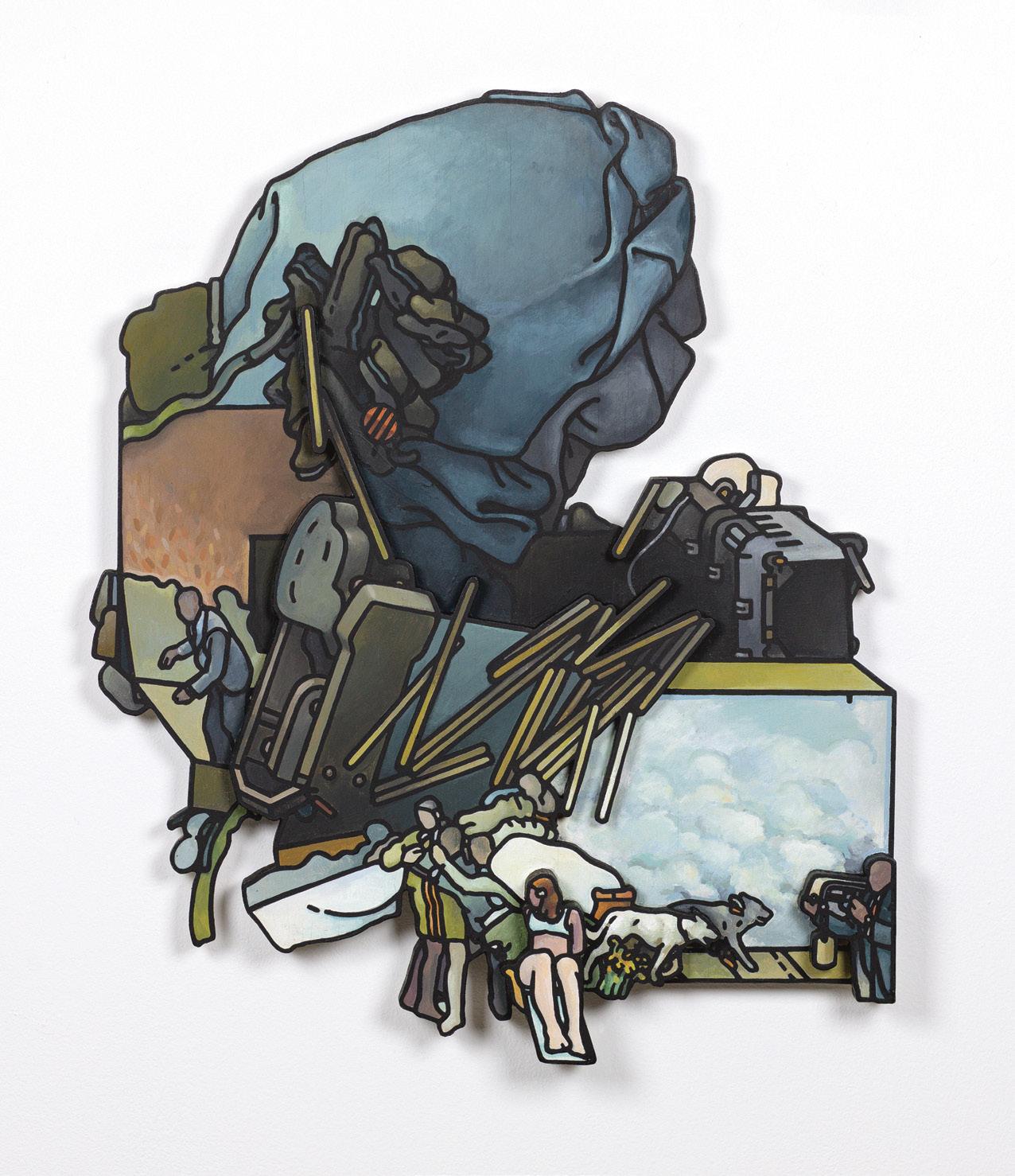

Isaacs: Trompe l’oeil goes back at least to the Greeks and Romans and is often considered somewhat shallow but entertaining. Probably rightly so. Being able to accurately depict objects is a fairly common skill among artists and not as hard to do as many people think. I have a self-taught still life painting of mine from age 16 which is highly detailed and “real” looking, yet dreadfully corny (literally, as there are ears of corn) and misses the point of seeing relationships and the whole rather than details. It’s the old “can’t see the woods for the trees” problem.
I do enjoy the nineteenth-century Americans (William Hartnett, John Haberle, John F. Peto) and the seventeenth-century Dutch, and some of our contemporaries, such as Tom Eckert, but I can’t say I’m really influenced by them.
I use trompe l’oeil in a functional way rather than as an, “oh, wow” end in itself. It’s meant to fortify the image and give it what I call the authority of direct visual observation. It is also an appropriate way of expressing my fascination with the visual world, especially with light and the mysterious physical presence of objects.
13
Ron’s Plywood London Fog Freaks Out, 1973
Acrylic paint on fir plywood and found wooden coat hanger
42 x 30 x 6 1/2 inches
Needless to say, when you’re painting on a three-dimensional surface you have a head start over the old guys. The trick is to combine the painting and the relief surface. My strategy is to build as much of the surface as I can with whatever skills and patience I have, then rely on the paint to carry the rest of the illusion. I enjoy the fusion and confusion of real and illusory space that results. Any illusion I manage to achieve is going to break down fairly quickly, and this is the fate of all trompe l’oeil. However, at least the viewer is left with the image—which is what you get from a “normal” work of art.
As to subject matter, trompe l’oeil relies on a shallow space. Clothing and plant materials and certain kinds of found objects can be made to stick fairly closely to the wall. They also interact with the negative spaces of the wall around them, and provide apparently endless opportunities for visual and metaphorical content. It’s a great cast of characters to work with. Sometimes, the garments and objects I use are like repertory actors, appearing in different works playing different roles.
But I must say, after talking so seriously about it—making trompe l’oeil that works surely is fun!
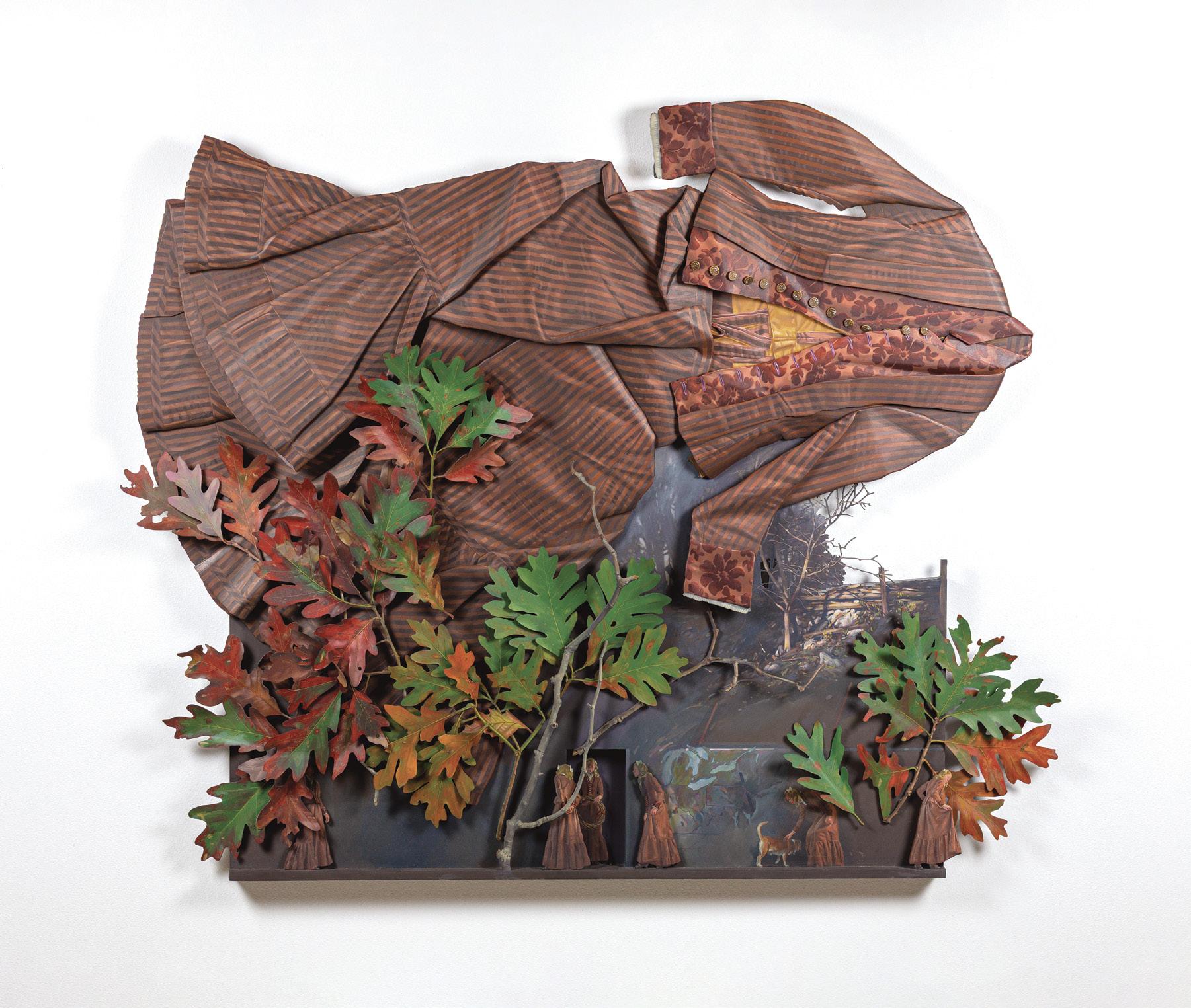
Pepich: What do you see as the main aesthetic message in your work? Has this changed over time?
Isaacs: My ideas are mostly visual ideas, rather than something that comes to me conceptually or verbally. I would be happy with just combining shapes, colors, and the other design components into strong compositions, putting things together. This is form, it’s the “art for art’s sake” tradition I was trained in. But form generates content in the human mind. Form is what you see, content is what you get. So, I try to put things together that don’t simply just “look right,” but evoke many possible readings and responses—and some real psychological resonance, if possible.
Okay, what does a dress from the 1950s “mean?” What if I put it together with this branch of dry leaves, or these found objects? What if I cut a box into it and put something in the box? One of my major strategies is to present something as being “real” and then to find a way to sabotage its reality with a paradoxical interruption, transition, or metamorphosis. That can be a surreal visual surprise, or a way to generate metaphors and other levels of meaning, or even question how we perceive reality.
I have finally learned to try not to discuss content, sometimes even with myself. As Robert Rauschenberg said, “When an artist explains their artwork, the viewer closes their eyes.”
I like open content that remains open and subject to revision even for me. I have no agenda or message that you have to “get.” What you experience in front of a work of art is yours, and of course you can absorb the experience as shallowly or as deeply as you are willing to go. I am often amazed and sometimes appalled at what viewers read into my works, but that’s the nature of art. The ultimate content of all art is simply what it’s like to be a human being.
My goal (other than to just make things—a compulsion if not an obsession) is always to make an interesting object . “Interesting” is a weak word, but I mean it in the best sense, as rewarding scrutiny and thought. (I don’t think that phrase is original with me, but since I can’t remember where I got it, it’s mine now.)
A favorite quote is from Claes Oldenburg, who said, “The harder I look at a thing, the more mysterious it becomes.” Yes. I’ll also quote myself, from my most recent artist’s statement: “Creating and exploring mysteries and performing feats of magic have always been part of art’s job description. In life, I will stand with science every time, but my work still likes to go out and play with the magic and the mystery.”
Has my aesthetic changed over time? It certainly changed very rapidly in the early 1970s, more slowly since—from a “more is more” approach to greater restraint that may be more effective. I originally thought of myself as a figure painter. Gradually, the figures went away so that the vintage garments themselves serve even more clearly as anthropomorphic stand-ins for the figure. The partnership of clothing and plant materials (leaves, sticks, occasionally flowers) showed up early in the works. It remains a rich source of what I consider visual poetry, with many possible meanings. The painting has become tighter and my craftsmanship has become increasingly more skilled, with more stages of refinement.

Pepich: How do you develop your ideas for compositions and series? Are there any drawbacks or particular challenges to working with the materials you favor? How does creating trompe l’oeil works affect your choice of materials and working methods?
Isaacs: Ideas for pieces come from everywhere. Some are genuine immediate inspirations; others bloom slowly over years. Many beginnings of works happen in doodles or small sketchbook drawings, which represent possible format ideas or combinations of elements and compositions. Almost never are larger drawings required. Many begin by simply finding something I’d like to use. And a lot of works begin by laying out a garment or object and working to compose the setup directly on the floor or table. (I can hardly put down three objects on a table without trying to arrange them into a composition. It’s instinctive.)
My pieces aren’t carved as such. I never learned to carve; the small amount I did in college sculpture classes seemed to be tedious labor. I make constructions of birch plywood with lots of sanding—which is in fact a form of carving, but the whole process is much more additive than subtractive. Making hard flat planes of plywood bend and flow like fabric and foliage requires some minor feats of design and engineering which I figured out a bit at a time. The process offers a challenge and some intriguing problems to solve in nearly every piece. Working this way makes me look at all potential subject matter (and much of the world) in terms of not just whether I could paint it (I probably could), but whether I could build it. It’s probably the wrong medium for my subject matter, but it’s the way the work developed. And it’s mine.
I’ll describe my process: I’m always looking at a real object, sometimes a whole still life setup, working one to one. The garment or plant material or whatever is pinned to a Styrofoam board which is gridded off into one-inch squares; I make a contour line drawing of it on similarly gridded paper. This is the master pattern, from which I begin to make pages of tracing paper patterns, analyzing the forms and planes of the subject which can be rendered by pieces of plywood—sometimes hundreds in a large or complicated piece. The first two or three days of a major work may be spent just making patterns. These are traced, using carbon paper, onto various thicknesses of Finnish or, in recent years, Baltic birch plywood (I can’t seem to get Finnish birch anymore), sawed out on my scroll saw, and glued together with wood glue in sections which I then join to make the whole. There is some wood filler, mostly to ease the “valley” joinings and to help with transitions, and then sanding with a belt-and-disc sander, a Dremel tool with tiny sanding drums, and by hand. These stages comprise about half the work of making the piece, and, at this point, it’s the equivalent of a painter stretching their canvas.
Painting involves a couple of coats of acrylic gesso, more sanding and refinement, more gesso, and then coats of the base colors in matte acrylic paints. I then model the forms in layers, shadows first, in three or four stages of increasing darkness with dry-brushing and thumb-smudging to blend out transitions. I use the same process to create highlights. Acrylic dries quite quickly, with very little time for blending, so I had to defy all my training and past experiences as a “painterly” painter to develop these techniques. I have fewer visible brushstrokes now, but I think it’s still painterly because I see painterly.
Pepich: What artistic movements, cultures, and artists’ works inspire you? Do objects and ideas from outside the art world also interest or serve as a resource?

Figure 16
Ron Isaacs
Imitation Knotty Pine Leaf Box with Apollo and Daphne (After Bernini), 1979
Acrylic paint on birch plywood 18 x 21 x 7 inches
Racine Art Museum, Gift of the Artist
Isaacs: As I said, I’m very visual, and I look at everything. I’m sure I make my wife a little crazy pointing out clouds, what the light is doing, or landscape colors in February. Some days, every leaf or stick on the sidewalk—or crack in the sidewalk, even—starts to look like art. Nature has always been a major source of design and inspiration and content, and I can’t help how clichéd that sounds.
I admire and look at a great variety of art from many artists from all periods— Egypt and Grinling Gibbons and Paul Cézanne and Martin Puryear and Anthony Caro. Contemporary ceramics is a big interest. Elizabeth Murray (Oh, my!) circa 1990, and too many more to go further with this list. On a more mundane level, even Pinterest can be a great source of idea-starter imagery and just things to look at, thousands of them.
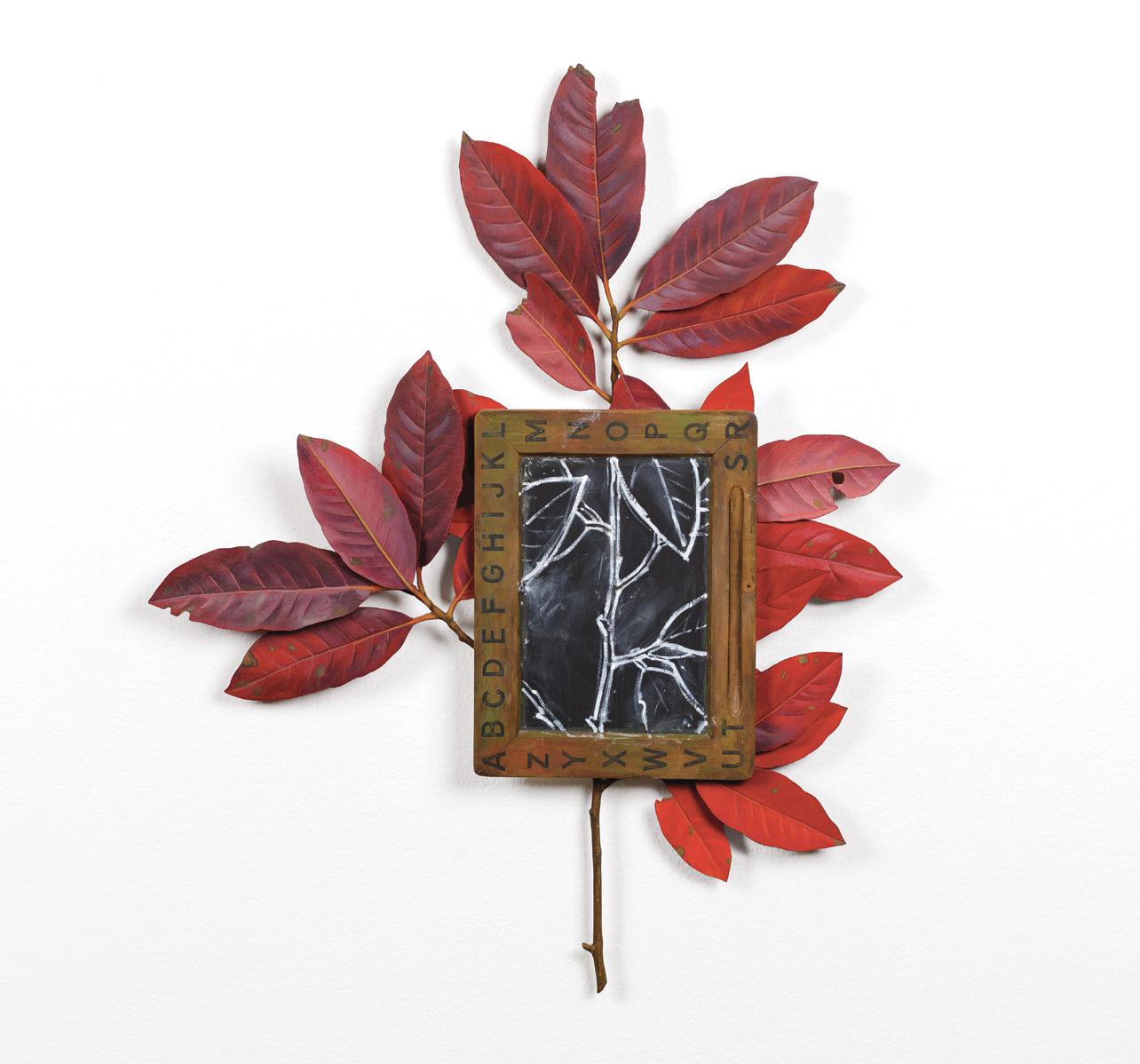
Pepich: Your work appears to occupy a place between high relief sculpture and painting. Do you think of your work as being part of the tradition of sculptural relief or does it flow out of the shaped canvas movement in paintings of the 1960s and 1970s?
Isaacs: If I’m confronted by a wall of artwork and objects, my attention will most likely go first to the items which are not rectangles, but something irregularly shaped and possibly three-dimensional. In recent years, the appreciation of contemporary crafts has occupied more of my thoughts than contemporary painting has. Truthfully, I’ve never considered my place, if any, in the long tradition of relief sculpture.
I liked Frank Stella’s and Charles Hinman’s geometric shaped canvases, but Lee Bontecou’s work and, of course, Elizabeth Murray’s were the most exciting to me.
Pepich: I will start this question by saying I don’t usually like to assign artists and their works to a specific sector of the fine arts field and it is becoming increasingly difficult to do so. However, with this in mind, wood assemblage is as important a component in your works as is the application of paint and your pieces are impeccably well crafted. Which sector of the art field— painting, sculpture, contemporary craft—do you see yourself having the best fit in if we were trying to classify you?
Isaacs: I’ve found that the easiest way to begin to describe my work is that it’s exactly halfway between painting and sculpture. Some galleries that categorize their artists have listed me under “sculpture,” but I trained as a painter and somehow that persists in my mind as what I am, even after over a half-century of working with wood. This has been a source of slowly dawning surprise as—instead of being thought of as a painter and “fine artist” (a ridiculous outmoded term) I’m often considered not only as a sculptor but as a woodworker and craftsman. Finding myself in the company of craftspeople is a fine place to be, and I’m not unhappy about it at all, but I still have a bit of imposter syndrome in the presence of real wood artists. I was put on a panel of woodworkers and wood sculptors once at SOFA Chicago and have seldom been so intimidated. 5 What if they find out I’m just a painter trying to make an interesting surface to hang paint on? I’ve never had the nerve to exhibit an unpainted construction, but some of them do look like decent relief sculptures.
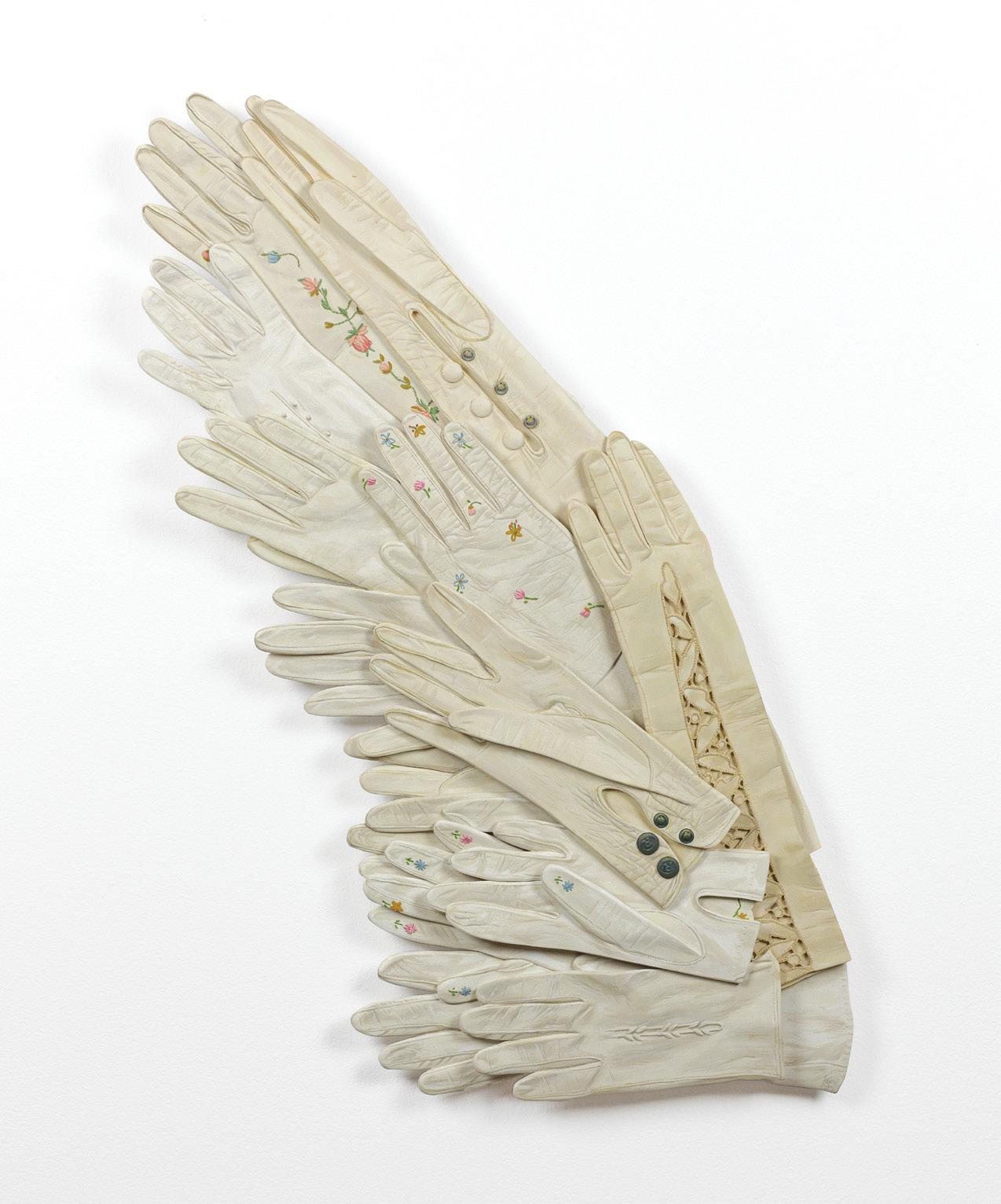
In fact, the construction phase and its refinement have become increasingly rewarding to me. I enjoy it more and more, while some of the painting seems a bit more tedious at times.
You’re on your own for classifying me; I call them trompe l’oeil painted constructions. I often told my students that the undefined territories between media were places worth exploring and excellent chances to be creative and original.
Pepich: Your work frequently references the domestic side of life by depicting clothing, household objects, flowers and plants, family photographs, etc. This kind of imagery enables you to suggest place and the passage of time through a sense of memory that is part of many of your works. Are memory and associations something the viewer projects onto the objects you depict in your work or do you think these objects embody these associations in their own right? Can you talk about the way disparate items in your compositions relate to each other or interact with the viewer?
Isaacs: Objects have memories and stories that cling to them through time. Some of the memories leave visible marks in patinas and signs of use and age, some are fragments of narratives that we remember or invent based on our own life experiences. The plant materials are timeless; the vintage garments are fixed in the past, but they carry their likely and unlikely stories into the present. My repertoire of subject matter is an especially evocative kind to use, but I’m aware that nostalgia is risky business for an artist. I have to try not to fall over into some kind of soupy sentiment. Children’s clothing is especially dangerous; I have to keep a little edge of some sort when I use it. Trying to foster a certain mystery and ambiguity of content in the works helps, I hope, as does my constant goal of a strong visual image with an effective presence and a solid composition.
Pepich: You are known for being an impeccable craftsman. Your techniques make possible the illusion of reality that you project in your work. What has greater importance to you—the concept or the execution—or do you value each equally?
Isaacs: The execution. The continuing joy of making, together with the continuing joy of seeing.
Pepich: The archive of your work at RAM spans the years 1971 through 2017 with paintings, a major drawing, sculptures, and jewelry. What kinds of benefits do you think this type of documentation provides for the featured artist, the field, and the public? Why did you choose RAM as a recipient of a number of your major works from you and donors you know?
Isaacs: You found a trompe l’oeil handsaw of mine in a Chicago gallery in 1990 and included it in one of your good-natured theme exhibitions at Wustum. It was a tool-themed show called Just Plane Screwy. I met you there, and I participated eventually in seven more of the theme shows. RAM became a destination, and I kept seeing you at SOFA, by which time you were a friend. Several years ago, you expressed an interest in collecting my work in depth. That was a golden opportunity I was eager to pursue, and the rest follows.
Bruce, I am absolutely thrilled and deeply honored to have this Collection Focus exhibition of my work (It’s a retrospective! And it’s at RAM!). The word “legacy” has been busy in my mind in recent years, and this is the biggest and best chunk of my legacy I have been able to imagine. It has a number of my favorite works, Greatest Hits, and milestones, and I am all-out grateful that you and RAM have taken them on—not only to exhibit now, but to keep them and preserve them. This is some of the best kind of support an artist can have. Thank you.

1 Ron Isaacs as quoted in interview with Bruce W. Pepich from this publication, Collection Focus: Ron Isaacs at RAM, Racine Art Museum, 2025. Reading Isaacs’s words about his process and ideas is as engaging as viewing the work.
2 Ibid.
3 Ron Isaacs quoted in Ron Isaacs: A Retrospective in 2 1/2 D Berea, KY: Berea College, 2011, 6.
4 From a certain standpoint, this moment of forgetting is even more important when context is considered. When encountered in a gallery or museum whose purpose is to show artwork, Isaacs’s work can still transcend expectations and hold illusion. When shown in spaces like the Racine Art Museum, it also might be shown in the midst of work made of actual found objects (not just represented ones) further doubling the confusion and then revelation that is a potential of experiencing his work.
5 SOFA is the Sculpture Objects Functional Art and Design exposition that focused on three-dimensional artwork and, especially, contemporary craft. These expositions, under this title, began in the 1990s as annual events held at Navy Pier in Chicago. SOFA grew out of an earlier series of art fairs held at Navy Pier in the 1980s that focused on three-dimensional artworks with an emphasis on craft called the Chicago International New Art Forms Exposition
19